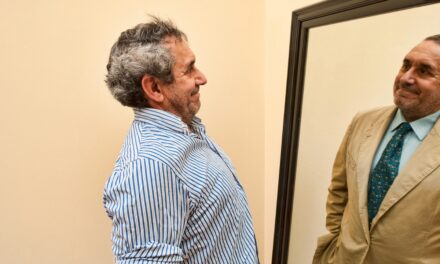Introduction: Embracing Mindfulness Through NLP
In the fast-paced rhythm of modern life, the quest for a serene mind amidst the chaos has led many to the practice of mindful living. Mindfulness, the art of being fully present and engaged in the moment, free from distraction or judgment, has been shown to improve everything from mental clarity to emotional stability. But how does one begin this journey towards tranquility and heightened awareness? The answer may lie in an unexpected ally: Neuro-linguistic programming (NLP).
NLP, a psychological approach that involves analyzing strategies used by successful individuals and applying them to reach a personal goal, offers a rich toolkit for those seeking a more mindful existence. It’s not just a set of techniques; it’s a philosophy, a mindset that can be woven into the fabric of daily life. For the uninitiated, NLP for better living might sound technical, but it’s essentially about fine-tuning the language we use internally and externally to foster positive change.
This blog post is crafted for the curious minds – students, educators, healthcare professionals, life coaches, business leaders, and even those managing households – who are new to the concept of NLP. We will explore how NLP techniques for mindfulness can be seamlessly integrated into your daily routines to promote a more attentive and reflective lifestyle. Whether you’re a coach looking to enrich your practice with digital marketing strategies or a therapist aiming to enhance client sessions, the mindfulness NLP strategies we’ll discuss are designed to be accessible, practical, and transformative.
As we delve into the world of neuro-linguistic programming mindfulness, we invite you to open your mind to the possibilities that NLP presents. It’s not just about self-improvement; it’s about redefining the way you experience life. By the end of this post, you’ll have a foundational understanding of how applying NLP for mindfulness can lead to profound personal growth and a more harmonious balance in every facet of your life. Let’s embark on this journey together, exploring how to enhance your mindfulness practice with the power of NLP.
The Intersection of Mindfulness and NLP
At first glance, mindfulness and Neuro-linguistic Programming (NLP) may appear to be distinct realms; one rooted in ancient meditative traditions, the other a modern psychological discipline. However, at their core, both seek to enrich the human experience through heightened awareness and strategic mental frameworks. This intersection forms a bridge between the timeless pursuit of inner peace and the contemporary methods of personal development.
Mindfulness encourages us to anchor ourselves in the present moment, to observe our thoughts and feelings without judgment. It’s a practice that teaches us to respond, rather than react, to the ebbs and flows of our emotional lives. NLP for mental wellness complements this beautifully by providing the linguistic and cognitive tools to reframe and recalibrate our internal dialogue. It’s about understanding the ‘programming’ language of our minds and using it to steer our thoughts in a direction that serves us.
The synergy between mindfulness techniques in NLP becomes evident when we consider the NLP presupposition that ‘the map is not the territory.’ This principle reminds us that our perception of the world is not the world itself but merely our interpretation of it. Mindfulness, too, teaches us that our thoughts are not facts but are subjective experiences. By integrating NLP practices for mindfulness, we can learn to observe our ‘maps’ and edit them for a more accurate, and often more positive, navigation of reality.
For those new to these concepts, think of NLP and mindfulness as two lenses that, when focused together, offer a clearer vision of your mental landscape. NLP techniques for mindfulness can be as simple as changing a single word in your self-talk that shifts your perspective from one of limitation to one of possibility. It’s these subtle yet powerful tweaks in our mental syntax that can lead to a more mindful and fulfilling life.
As we explore NLP strategies for living mindfully, we’ll discover how to harness the power of both disciplines to not only live more presently but to also shape our future experiences with intention and clarity. This harmonious blend is what makes NLP for a mindful lifestyle not just a method for personal growth, but a transformative life practice.
Fundamental NLP Techniques for Mindfulness
Embarking on the path of mindfulness through NLP begins with understanding and applying some fundamental techniques. These methods are not just theoretical concepts; they are practical tools that can be applied to the tapestry of daily life, offering a scaffold for those new to mindful living with NLP.
Anchoring is one of the most powerful NLP techniques, allowing individuals to evoke positive states of being at will. Imagine a teacher, before a challenging class, recalling a moment of profound connection with students. By holding onto a physical touchpoint, like a gentle press of the fingers, during that positive recall, they create an ‘anchor.’ Later, activating this anchor can bring back the same sense of calm and connection, fostering a mindful state amidst classroom chaos.
Reframing is another cornerstone of NLP, pivotal in enhancing mindfulness with NLP. It involves altering the frame through which a situation is viewed. For instance, a doctor facing a demanding patient might reframe the experience from a stress-inducing encounter to an opportunity to practice patience and empathy. This shift in perspective can transform moments of tension into opportunities for mindful growth.
Visualization is a technique where mental imagery is used to simulate desired outcomes. A businessperson might visualize a successful negotiation, focusing on the clarity of communication and the feelings of accomplishment. This mental rehearsal primes the mind for success, aligning subconscious resources with conscious efforts, and promoting a mindful approach to professional interactions.
Modeling is an NLP strategy where individuals learn by adopting the behaviors, language, and beliefs of those who have already achieved what they aspire to. A counselor observing a more experienced colleague may model their therapeutic presence, absorbing the nuances of mindful listening and empathetic interaction.
Meta-Model questions are a set of probing questions designed to clarify thoughts. A coach might use these to help clients break down barriers to personal growth, encouraging a deeper level of mindfulness about their internal narratives.
Submodalities involve changing the ‘submodalities’ of how we experience a memory or thought. For example, a therapist might help a client alter the ‘brightness’ or ‘volume’ of a traumatic memory, making it less intense and more manageable, thus enabling a more mindful and less reactive mental state.
Incorporating these NLP mindfulness exercises into daily routines can be transformative. A student anxious about exams can use anchoring to recall a state of focused calm. A housewife overwhelmed by the day’s chores can reframe her tasks as opportunities for mindfulness and presence. By applying these NLP techniques for mindfulness, individuals from all walks of life can begin to experience moments of clarity and peace, even in the midst of a bustling world.
Through these foundational NLP techniques, we can all start to cultivate a more mindful approach to our lives, enhancing our capacity for presence, empathy, and emotional resilience. It’s not just about being mindful in the quiet moments of meditation but about bringing that mindfulness into the dynamic flow of everyday living.
Enhancing Daily Routines with NLP
Incorporating NLP into our daily routines can act as a catalyst for sustained mindful living. It’s about making mindfulness not just an isolated practice but an integrated part of our everyday lives. Here’s how we can enhance our daily routines with NLP, creating a tapestry of mindfulness that weaves through our day.
Morning Mindset Adjustment: Begin the day with intention. Use NLP’s mindfulness NLP strategies to set a positive tone. Upon waking, take a few moments to visualize the day ahead going exactly as you wish. See yourself handling tasks with competence and conversations with grace. This primes your subconscious to align with these intentions, infusing your day with a mindful presence from the start.
Mindful Commutes with NLP: Transform idle time into opportunities for growth. If you’re a professional commuting to work, listen to NLP audio programs or practice positive affirmations. This is a form of NLP for life balance, turning a potentially stressful commute into a time for personal development.
NLP Lunchtime Reset: Midday, engage in a brief NLP mindfulness exercise. Find a quiet space, practice deep breathing, and anchor yourself in the present. This reset helps you maintain a state of mindfulness throughout the afternoon, even during the busiest of workdays.
Evening Reflection with NLP: As the day winds down, reflect on your experiences. Use NLP’s mindful communication techniques to discuss the day with family or friends, focusing on listening actively and speaking with intention. This not only enhances relationships but also solidifies the day’s mindful practices.
NLP for a Mindful Lifestyle: Before bed, engage in a reflective NLP practice, such as journaling about the day’s events and your reactions to them. This is not only a way of applying NLP for mindfulness but also helps in processing emotions and experiences, leading to a peaceful night’s sleep.
By embedding these NLP techniques into our daily activities, we can transform routine actions into moments of mindfulness. Whether it’s a student preparing for exams, a businessman navigating negotiations, or a housewife managing household tasks, NLP and mindful living tips can turn everyday experiences into a practice of presence and awareness. It’s these small, consistent practices that build the foundation for a life lived with intention, balance, and a deep sense of mindfulness.
NLP for Mental Wellness and Communication
The application of NLP transcends mere self-improvement; it’s a potent tool for fostering mental wellness and enhancing communication. By integrating NLP strategies, individuals can develop a resilient mindset and cultivate relationships that are both meaningful and nurturing.
Mental Wellness through NLP: NLP’s approach to mental wellness centers on the premise that our thoughts shape our reality. By using NLP techniques for mindfulness, such as reframing negative thoughts or challenging limiting beliefs through the Meta-Model, individuals can construct a more positive mental landscape. For instance, a therapist might guide a client to shift from the thought “I am anxious about speaking in public” to “I am excited to share my ideas with others.” This subtle linguistic tweak can transform anxiety into anticipation, promoting a healthier mental state.
Mindful Communication with NLP: Communication is a cornerstone of our social existence, and NLP offers tools for more mindful interactions. NLP mindful communication techniques encourage active listening and empathetic response. They teach us to truly hear what is being said, and perhaps more importantly, what is left unsaid. This can be particularly valuable for coaches and counselors who rely on building trust and understanding with their clients. By mirroring body language and matching linguistic patterns, professionals can create a rapport that facilitates deeper dialogue and connection.
NLP in Conflict Resolution: Conflict, whether in personal or professional settings, can be a significant source of stress. NLP provides strategies for navigating disagreements with a calm and focused demeanor. Techniques like outcome framing help individuals to focus on the desired resolution rather than the conflict itself, paving the way for solutions that are beneficial for all parties involved.
NLP for Stress Reduction: Stress is often a byproduct of feeling out of control or overwhelmed by circumstances. NLP offers a suite of strategies for stress reduction, including anchoring calm states and using dissociation techniques to gain perspective on stressful situations. By practicing these techniques, individuals can maintain a state of mindfulness even under pressure, leading to improved mental wellness.
Incorporating NLP into mental wellness and communication practices not only enhances personal well-being but also strengthens the fabric of our interactions with others. It equips us with the skills to navigate life’s challenges with grace and to connect with others on a level that promotes mutual understanding and respect. Through mindful application of NLP, we can achieve a state of mental balance that resonates through every word we speak and every action we take.
NLP in Professional Settings
In professional environments, the application of NLP can be particularly transformative. It equips individuals with the skills to excel in their roles while fostering a workplace culture of mindfulness and continuous growth.
For Educators: Teachers can utilize NLP for personal growth in the classroom to enhance their teaching methods. By employing NLP strategies, such as matching and mirroring student language and body language, educators can create a more engaging and supportive learning environment. This not only aids in student retention but also in building a rapport that encourages open communication and learning.
Healthcare Professionals: Doctors and therapists can integrate mindfulness NLP strategies to improve patient interactions. Techniques like active listening and reframing can help patients articulate their concerns more clearly and shift their perspective towards a more positive outlook on their health journey.
Business Leaders: In the boardroom, NLP mindfulness exercises can be used for conflict resolution and to negotiate with empathy. Businessmen can apply NLP techniques to enhance decision-making processes, leading to outcomes that are beneficial for the company and its employees.
For Coaches and Counselors: These professionals can use NLP mindful communication to deepen their client relationships. By modeling excellence and facilitating goal-oriented conversations, they can guide their clients towards achieving personal and professional milestones.
In every professional setting, NLP serves as a bridge to clearer communication, better relationships, and more effective leadership. It’s a tool that not only promotes individual excellence but also contributes to the creation of a mindful, cohesive, and productive work environment.
Advanced Mindfulness Techniques in NLP
For those looking to deepen their mindfulness practice, advanced NLP techniques offer a pathway to greater self-awareness and mastery over one’s mental processes.
Logical Levels of Change: This advanced NLP concept involves examining and aligning one’s environment, behavior, capabilities, beliefs and values, identity, and purpose. For instance, a coach might guide a client through these levels to ensure their goal of becoming more mindful aligns with their deeper values and sense of self, thereby facilitating profound and lasting change.
The Milton Model: This set of linguistic patterns is used to communicate with the subconscious mind. It can be particularly effective in guiding meditation or hypnotherapy sessions, helping individuals to access a deeper state of mindfulness and relaxation.
Time Techniques: These involve manipulating one’s perception of time to enhance mindfulness. By mentally ‘stepping out’ of the current moment and viewing it from a future point, individuals can gain perspective on their present emotions and actions, leading to more mindful decision-making.
By mastering these advanced techniques, individuals can not only improve their own mindfulness practice but also assist others in achieving a more profound sense of presence and awareness. These strategies are particularly valuable for those in helping professions, such as therapists and coaches, who aim to facilitate deep, transformative growth in their clients.
Case Studies and Success Stories
Real-world applications of NLP techniques provide compelling evidence of their effectiveness in fostering a more mindful lifestyle. Here are brief snapshots of success stories:
Case Study 1: The Overwhelmed Executive: Ajay, a high-level executive, was struggling with work-life balance. Through NLP’s reframing technique, he learned to view his long hours as a choice rather than an imposition, which led to a significant shift in his attitude towards work. He began to prioritize tasks more mindfully, leading to increased productivity and more time for personal activities.
Case Study 2: The Anxious Student: Rita, a university student, suffered from test anxiety. An NLP practitioner helped her develop an anchoring technique, associating feelings of calm and concentration with a specific gesture. By activating this anchor before exams, Maria’s performance improved, and her anxiety decreased markedly.
Success Story: The Transformative Coach: Sunita, a life coach, incorporated mindfulness and NLP training into her practice. By teaching her clients NLP-based mindfulness strategies, she witnessed remarkable growth in their personal and professional lives, with many achieving goals they previously thought unattainable.
These cases illustrate the tangible benefits of integrating NLP techniques into daily life. They serve as inspiration for anyone on the path to a more mindful and balanced existence, showcasing the transformative potential of NLP when applied with intention and skill.
Conclusion
As we’ve explored, NLP offers a rich array of techniques that can significantly enhance the practice of mindful living. From the simple yet profound act of reframing thoughts to the deeper strategies of aligning one’s values and identity, NLP provides actionable pathways to a more present and balanced life. Whether you’re a professional seeking to integrate mindfulness into your practice or an individual on a journey of personal growth, the fusion of NLP and mindfulness holds the promise of transformation. Embrace these tools, and step into a life of greater clarity, purpose, and peace.










